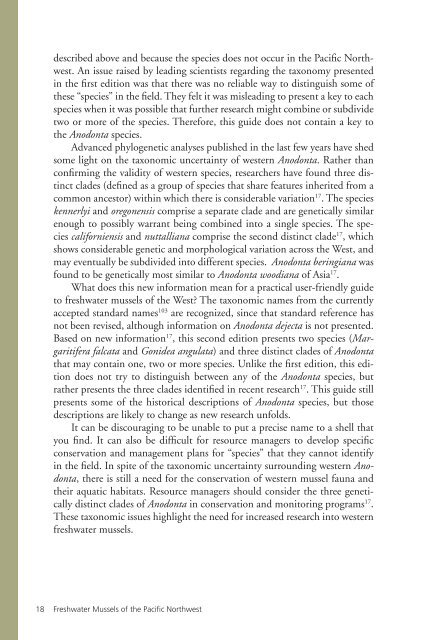Freshwater Mussels Pacific Northwest - The Xerces Society
Freshwater Mussels Pacific Northwest - The Xerces Society
Freshwater Mussels Pacific Northwest - The Xerces Society
You also want an ePaper? Increase the reach of your titles
YUMPU automatically turns print PDFs into web optimized ePapers that Google loves.
18<br />
described above and because the species does not occur in the <strong>Pacific</strong> <strong>Northwest</strong>.<br />
An issue raised by leading scientists regarding the taxonomy presented<br />
in the first edition was that there was no reliable way to distinguish some of<br />
these “species” in the field. <strong>The</strong>y felt it was misleading to present a key to each<br />
species when it was possible that further research might combine or subdivide<br />
two or more of the species. <strong>The</strong>refore, this guide does not contain a key to<br />
the Anodonta species.<br />
Advanced phylogenetic analyses published in the last few years have shed<br />
some light on the taxonomic uncertainty of western Anodonta. Rather than<br />
confirming the validity of western species, researchers have found three distinct<br />
clades (defined as a group of species that share features inherited from a<br />
common ancestor) within which there is considerable variation 17 . <strong>The</strong> species<br />
kennerlyi and oregonensis comprise a separate clade and are genetically similar<br />
enough to possibly warrant being combined into a single species. <strong>The</strong> species<br />
californiensis and nuttalliana comprise the second distinct clade 17 , which<br />
shows considerable genetic and morphological variation across the West, and<br />
may eventually be subdivided into different species. Anodonta beringiana was<br />
found to be genetically most similar to Anodonta woodiana of Asia 17 .<br />
What does this new information mean for a practical user-friendly guide<br />
to freshwater mussels of the West? <strong>The</strong> taxonomic names from the currently<br />
accepted standard names 103 are recognized, since that standard reference has<br />
not been revised, although information on Anodonta dejecta is not presented.<br />
Based on new information 17 , this second edition presents two species (Margaritifera<br />
falcata and Gonidea angulata) and three distinct clades of Anodonta<br />
that may contain one, two or more species. Unlike the first edition, this edition<br />
does not try to distinguish between any of the Anodonta species, but<br />
rather presents the three clades identified in recent research 17 . This guide still<br />
presents some of the historical descriptions of Anodonta species, but those<br />
descriptions are likely to change as new research unfolds.<br />
It can be discouraging to be unable to put a precise name to a shell that<br />
you find. It can also be difficult for resource managers to develop specific<br />
conservation and management plans for “species” that they cannot identify<br />
in the field. In spite of the taxonomic uncertainty surrounding western Anodonta,<br />
there is still a need for the conservation of western mussel fauna and<br />
their aquatic habitats. Resource managers should consider the three genetically<br />
distinct clades of Anodonta in conservation and monitoring programs 17 .<br />
<strong>The</strong>se taxonomic issues highlight the need for increased research into western<br />
freshwater mussels.<br />
<strong>Freshwater</strong> <strong>Mussels</strong> of the <strong>Pacific</strong> <strong>Northwest</strong>

















